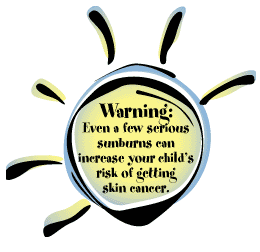How Can I Protect My Children from the Sun?
Just a few serious sunburns can increase your child’s risk of skin cancer later in life. Kids don’t have to be at the pool, beach, or on vacation to get too much sun. Their skin needs protection from the sun’s harmful ultraviolet (UV) rays whenever they’re outdoors.
- Seek shade. UV rays are strongest and most harmful during midday, so it’s best to plan indoor activities then. If this is not possible, seek shade under a tree, an umbrella, or a pop-up tent. Use these options to prevent sunburn, not to seek relief after it’s happened.
- Cover up. When possible, long-sleeved shirts and long pants and skirts can provide protection from UV rays. Clothes made from tightly woven fabric offer the best protection. A wet T-shirt offers much less UV protection than a dry one, and darker colors may offer more protection than lighter colors. Some clothing certified under international standards comes with information on its ultraviolet protection factor.
- Get a hat. Hats that shade the face, scalp, ears, and neck are easy to use and give great protection. Baseball caps are popular among kids, but they don’t protect their ears and neck. If your child chooses a cap, be sure to protect exposed areas with sunscreen.
- Wear sunglasses. They protect your child’s eyes from UV rays, which can lead to cataracts later in life. Look for sunglasses that wrap around and block as close to 100% of both UVA and UVB rays as possible.
- Apply sunscreen. Use sunscreen with at least SPF 15 and UVA and UVB (broad spectrum) protection every time your child goes outside. For the best protection, apply sunscreen generously 30 minutes before going outdoors. Don’t forget to protect ears, noses, lips, and the tops of feet.
Take sunscreen with you to reapply during the day, especially after your child swims or exercises. This applies to waterproof and water-resistant products as well.
Follow the directions on the package for using a sunscreen product on babies less than 6 months old. All products do not have the same ingredients; if your or your child’s skin reacts badly to one product, try another one or call a doctor. Your baby’s best defense against sunburn is avoiding the sun or staying in the shade.
Keep in mind, sunscreen is not meant to allow kids to spend more time in the sun than they would otherwise. Try combining sunscreen with other options to prevent UV damage.
Too Much Sun Hurts

Turning pink? Unprotected skin can be damaged by the sun’s UV rays in as little as 15 minutes. Yet it can take up to 12 hours for skin to show the full effect of sun exposure. So, if your child’s skin looks “a little pink” today, it may be burned tomorrow morning. To prevent further burning, get your child out of the sun.
Tan? There’s no other way to say it—tanned skin is damaged skin. Any change in the color of your child’s skin after time outside—whether sunburn or suntan—indicates damage from UV rays.
Cool and cloudy? Children still need protection. UV rays, not the temperature, do the damage. Clouds do not block UV rays, they filter them—and sometimes only slightly.
Oops! Kids often get sunburned when they are outdoors unprotected for longer than expected. Remember to plan ahead, and keep sun protection handy—in your car, bag, or child’s backpack.
Sun Safety in Schools

The Protect Your Students from Skin Cancer fact sheet [PDF-4.7MB] explains how educators can help lower students’ skin cancer risk.

Sun Safety in Schools: What You Can Do [PDF-860KB] explains how school staff, parents, and health care providers can promote sun safety.

The manual Shade Planning for America’s Schools [PDF-1.2MB] helps ensure school grounds have adequate shade.
- Page last reviewed: April 25, 2017
- Page last updated: April 27, 2017
- Content source:
- Maintained By:


 ShareCompartir
ShareCompartir